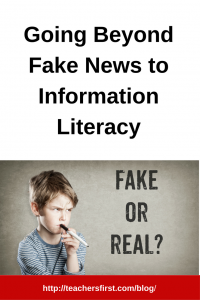 Fake news and stories about fake news are everywhere right now. In a recent blog post, I shared criteria for judging online resources, including news stories, using the CRAAP test. However, since this topic is of critical importance to our students, it merits another look. In fact, digitally literate teachers who teach their students to be information literate know that there is nothing new under the sun.
Fake news and stories about fake news are everywhere right now. In a recent blog post, I shared criteria for judging online resources, including news stories, using the CRAAP test. However, since this topic is of critical importance to our students, it merits another look. In fact, digitally literate teachers who teach their students to be information literate know that there is nothing new under the sun.
As far back as the early 2000s, we digitally-literate educators were teaching lessons on how to spot a fake website. We recommended Snopes and FactCheck.org to students and colleagues to check out those urban myths: no rats in chicken buckets or Facebook making us pay. We ardently listened to Frank W. Baker & Kathy Schrock, who helped us navigate this new world. If we were school librarians or lucky enough to have one in our building or district, we used resources designed for our K-12 students found in paid online references databases purchased by our districts or paid for by our states using Library Services and Technology Act grants. Examples included online encyclopedias, magazine indexes and content specific resources for STEM, social studies, and literature.
As we discussed digital citizenship and internet safety with our students, we emphasized not sharing any personal or directory information. We gave them the tools to be safe and smart online, for example, this video called “Friend or Fake?” from Netsmartz. But, we reminded our students and our administrators, that using the Internet was not just about safety. As far back as 1998, literally ancient history for the Internet, Doug Johnson was questioning school filtering. So we had discussions with our technology staff about not over-filtering students’ searching results. Students live in the real world we argued. Isn’t it better to give them the tools to use the Internet appropriately both at school and at home by having access to sites that the school often blocks? YouTube, Twitter and any URL that has been shortened come to mind after seeing numerous complaints on education listservs about being denied access at school for both teachers and students. A 2016 article in the Atlantic by Melissa D. Anderson summarized the controversy and pointed out it is an equity issue. Middle-class students usually have the Internet, thus more access at home, while low-income students do not, hampering their after-hours school work. Anderson says in the article about our students that “ultimately they live in an unfiltered world.” We do them a disservice if we do not teach them how to use the online world that they live in every day.
Information Literacy as defined by the Association of College and Research Libraries “is a set of abilities requiring individuals to recognize when information is needed and have the ability to locate, evaluate, and use effectively the needed information … Information literacy forms the basis for lifelong learning … Information literacy is related to information technology skills, but has broader implications for the individual, the educational system, and for society.” Many school librarians utilized the Big6 Skills curriculum created by Michael Eisenberg and Robert E. Berkowitz to teach information literacy skills, including how to do research.
As recently as January 2017 in his blog, Doug Johnson shared his thoughts on the importance of information literacy, “Will We Now Take Information Literacy Skills Seriously?” Besides including a helpful infographic with tips for spotting fake news, he offers in his light-hearted, but thoughtful style “six Information Jungle Survival Tips for Teachers and Students.” The last tip, ”prepare for the next journey by learning from the last,” suggests we must help our students become lifelong learners by having appropriate assessments of their information literacy skills. A great place to begin is to use TRAILS, Tools for Real-time Assessment of Information Literacy Skills. TRAILS provides online multiple-choice tests designed for grades 3, 6, 9, 12, but can be used at any level from grade 3 and up. Teachers create accounts for themselves and their students. After assessing the information literacy competencies of your students, start to include instruction on skills they need to know. However, teaching these skills as stand-alone curriculum divests them of their importance and immediacy. Instead, incorporate information literacy skills right in your daily lessons and classroom activities. Start today by talking about fake news, for example, here’s an idea from a Knowledge Quest article by school librarian Mica Johnson that helps students decide if memes are fake. Let’s take our students from fake news to information literacy, critical skills for school and life.

